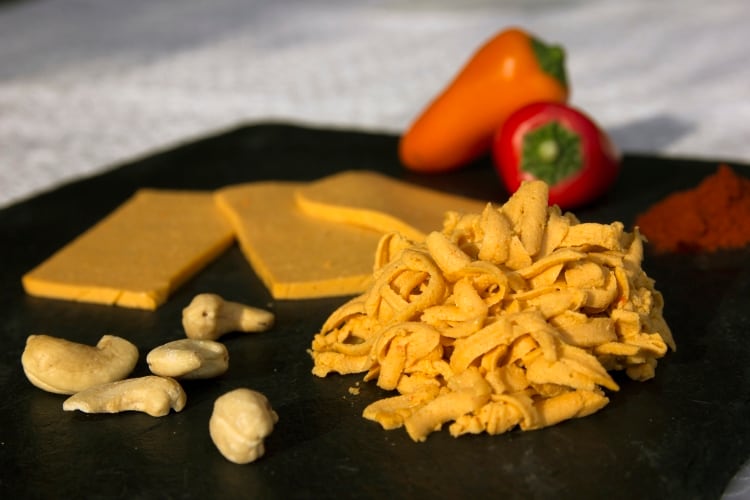And while the number of dairy alternative products is rising, matching the texture, flavor and properties of dairy products can be a challenge.
Natural cheese and vegan-substitute cheese differ significantly, from the ingredients used, the nutritional composition, the pathways by which flavor is generated and the process methods used. However, consumers expect vegan cheese substitutes to deliver in all areas.
Synergy Flavours works with companies to provide solutions to these complex issues.
When developing dairy-free cheese alternatives, texture and taste are the key considerations, Synergy Flavours told DairyReporter.
Texture is important for both the ‘eat’ and functionality in terms of slicing, shredding and melt, and is typically managed through the use of speciality starches.
Achieving the same or similar taste is a bigger challenge, according to Lorraine Kelly, category manager at Synergy Flavours. In natural cheese, flavor generation is derived from many sources throughout the process and ripening. For most vegan alternatives available on the market, flavor is created by the addition of a topnote flavoring and, in some cases, yeast extract, Kelly said.
“When you consider the complexity of flavor and the means by which flavor is generated in natural cheese, it is a big ask for a topnote flavor to achieve the same result.”
The craft and science of cheese
Cheese making has been practiced in most cultures since ancient times (it has been traced back as far as 5,000 years to Ancient Egypt).
Natural cheese is a milk concentrate consisting mainly of protein and fat (e.g. 25% protein & 32% fat in Cheddar), the major nutrients in addition to protein are calcium, zinc, phosphorous, vitamins A, B2 and B12 – which all have proven health benefits.
Cheese comes in many varieties determined by the ingredients, processing, and characteristics of the cheese. The moisture content of the cheese serves to distinguish various categories, such as hard (low-moisture), semi-hard and soft cheeses. Each category is distinguished by characteristics such as structure (texture, body), flavor and appearance, which result from the type of milk, the choice of bacteria and the manufacturing technique employed.
Cheese is made from a variety of mammals, and can be made using pasteurized or raw milk, each imparting different flavors and texture characteristics to the finished cheese.
The unique taste, texture and color of a cheese starts with the source and quality of the milk it is made from. Milk from cows fed naturally outdoors on pasturelands is rich in beta carotene, which gives the cheese a distinctive taste and texture and contains increased concentrations of omega-3 fatty acids, Kelly said.
The essential additives in the cheese-making process for most types of cheese, such as Cheddar or Swiss, are the starter culture and rennet. The starter culture is very important as it performs several duties including acidifying the milk, influencing the texture e.g. firmness, round holes or eyes such as those in Swiss, and the ripening process in hard and certain semi-hard cheese. It influences the breakdown of protein into peptides and amino acids, a key flavor pathway for the generation of flavor characteristics in Cheddar.
There are a wide variety of bacterial cultures available to provide distinct flavors and textural characteristics to cheeses. The temperatures, times, and target pH for different steps, the sequence of processing steps, the use of salting or brining, block formation, and aging vary considerably between cheese types and all play an important role in the final flavour characteristics, Kelly added.
Vegan cheese alternatives are typically made using coconut fat, starch, colors, flavoring additives and added vitamin B12, she noted.
“It may be surprising to many consumers that it contains virtually no protein (branded and own label ranges contain 0.7% or less protein) and no calcium.
“Those following a vegan diet must obtain these nutrients from elsewhere.”
Vegan cheese substitutes therefore plays a very specific role – of adding flavor and texture to vegan foods.
The taste difference
Emulating the complexity of flavor derived from the raw ingredients and processes used in cheese making, is technically incredibly challenging, according to Kelly.
Through its analytical flavor extraction and creation knowledge, Synergy Flavours has created a new vegan-suitable dairy flavor range.
It has been specifically designed to help manufacturers deliver flavor and improved mouthfeel in a wide variety of applications including vegan cheese alternatives, as well as ready meal sauces, snacks and baked goods. The range currently includes cream, milk, cheese and caramelized butter flavors, all of which deliver the dairy texture consumers expect.
Kelly said, “Our pioneering group approach in cheese and dairy ingredients employs innovative starter, enzyme and process technologies. Synergy has been able to leverage this science and understanding of cheese flavor pathways to create great tasting flavors suitable for vegan products. New profiles which include vintage Cheddar, Parmesan and Emmental will soon be available on the market.”

